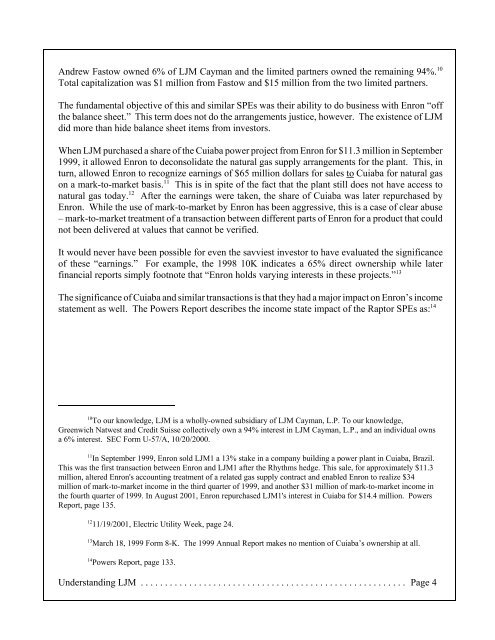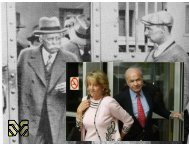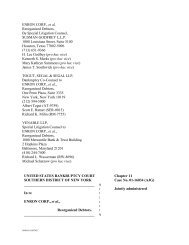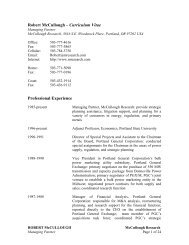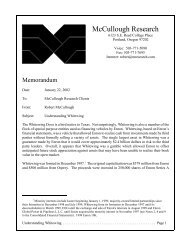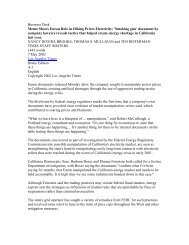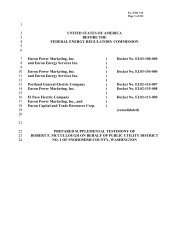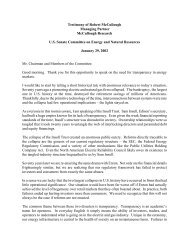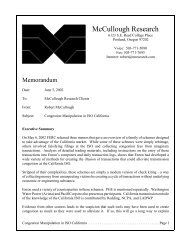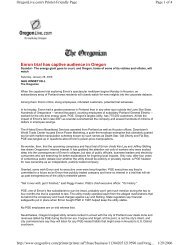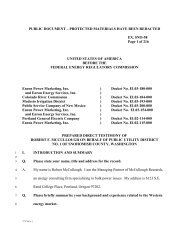Understanding LJM - McCullough Research
Understanding LJM - McCullough Research
Understanding LJM - McCullough Research
You also want an ePaper? Increase the reach of your titles
YUMPU automatically turns print PDFs into web optimized ePapers that Google loves.
Andrew Fastow owned 6% of <strong>LJM</strong> Cayman and the limited partners owned the remaining 94%. 10<br />
Total capitalization was $1 million from Fastow and $15 million from the two limited partners.<br />
The fundamental objective of this and similar SPEs was their ability to do business with Enron “off<br />
the balance sheet.” This term does not do the arrangements justice, however. The existence of <strong>LJM</strong><br />
did more than hide balance sheet items from investors.<br />
When <strong>LJM</strong> purchased a share of the Cuiaba power project from Enron for $11.3 million in September<br />
1999, it allowed Enron to deconsolidate the natural gas supply arrangements for the plant. This, in<br />
turn, allowed Enron to recognize earnings of $65 million dollars for sales to Cuiaba for natural gas<br />
on a mark-to-market basis. 11 This is in spite of the fact that the plant still does not have access to<br />
natural gas today. 12 After the earnings were taken, the share of Cuiaba was later repurchased by<br />
Enron. While the use of mark-to-market by Enron has been aggressive, this is a case of clear abuse<br />
– mark-to-market treatment of a transaction between different parts of Enron for a product that could<br />
not been delivered at values that cannot be verified.<br />
It would never have been possible for even the savviest investor to have evaluated the significance<br />
of these “earnings.” For example, the 1998 10K indicates a 65% direct ownership while later<br />
financial reports simply footnote that “Enron holds varying interests in these projects.” 13<br />
The significance of Cuiaba and similar transactions is that they had a major impact on Enron’s income<br />
statement as well. The Powers Report describes the income state impact of the Raptor SPEs as: 14<br />
10 To our knowledge, <strong>LJM</strong> is a wholly-owned subsidiary of <strong>LJM</strong> Cayman, L.P. To our knowledge,<br />
Greenwich Natwest and Credit Suisse collectively own a 94% interest in <strong>LJM</strong> Cayman, L.P., and an individual owns<br />
a 6% interest. SEC Form U-57/A, 10/20/2000.<br />
11<br />
In September 1999, Enron sold <strong>LJM</strong>1 a 13% stake in a company building a power plant in Cuiaba, Brazil.<br />
This was the first transaction between Enron and <strong>LJM</strong>1 after the Rhythms hedge. This sale, for approximately $11.3<br />
million, altered Enron's accounting treatment of a related gas supply contract and enabled Enron to realize $34<br />
million of mark-to-market income in the third quarter of 1999, and another $31 million of mark-to-market income in<br />
the fourth quarter of 1999. In August 2001, Enron repurchased <strong>LJM</strong>1's interest in Cuiaba for $14.4 million. Powers<br />
Report, page 135.<br />
12 11/19/2001, Electric Utility Week, page 24.<br />
13 March 18, 1999 Form 8-K. The 1999 Annual Report makes no mention of Cuiaba’s ownership at all.<br />
14<br />
Powers Report, page 133.<br />
<strong>Understanding</strong> <strong>LJM</strong> ....................................................... Page 4


